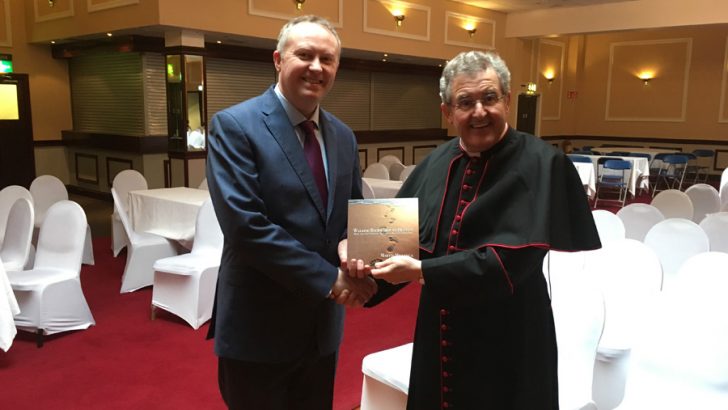Walking Backwards to Heaven? Hope and the Catholics of Cloyne Diocese, 1700 – 1830
by Martin Millerick (Diocese of Cloyne, €10.00 + 3.40 Postage Eire, €5.70 UK; Cathedral Bookshop, Cobh, Cloyne Diocesan Office & bookshops)
Martin Millerick’s new book is a scholarly history of the Catholic diocese of Cloyne in the 17th and 18th Centuries. The author highlights the complex relationships between the major players in the diocese at that time.
He shows how their relationships with the Protestant establishment varied in different places and at different periods.
For instance in the wake of the 1798 rebellion the Protestant landowners, the Catholic priests and the army were all as one! From 1700 onwards the Catholics in the Cloyne diocese area developed an independent institution which existed parallel to the Protestant civil administration and the established Church of Ireland.
Contributing to this progressive development were some of the leading ancient princely families who managed to retain their lands. Among these were the Imokilly Fitzgeralds, the Cotters of Carrigtwohill, as well as the Hennessys and Nagles of the Blackwater Valley. They provided the wealth, personnel and a stable environment for their church to develop and maintain its structures.
Cloyne was fortunate in having courageous and pastoral-minded bishops such as Matthew McKenna, William Coppinger, and Michael Collins. Bishop McKenna’s Visitation Book, 1785 evinces the priority he placed on education. As well as that of the priests he assesses the work of the teachers in the parishes of the diocese. He ensured the continuing education of the clergy, largely by organising routine clerical conferences throughout the deaneries.
Despite the outlawing of their religion the people continued to practise it. They built their Mass houses and, despite their dire poverty, generously supported their priests. There is evidence, which may surprise modern readers, that in some parts of the diocese of Cloyne priests enjoyed a comfortable life-style!
Relations between the authorities and the people were for the most part peaceful. However, there were also periods of extreme oppression. These occurred when members of the Protestant establishment felt insecure. Thus there were severe repressions following Col. Richard Hennessy’s recruiting mission for the Irish Brigade in the 1730s, the Stuart uprising in Scotland in 1744/5, and in the wake of the 1798 rebellion.
Most of the Cloyne priests received their formation in colleges on the continent. In this way new devotions and liturgical practices were introduced from Europe”
A number of individual acts of oppression became notorious. Séamus Óg Mac Coitir was hanged in 1720 because “the Protestants hated him for his independent spirit”. Fr Neal, the parish priest of Doneraile, was publicly horse-whipped by Lord Doneraile (of the St Leger family) in 1771 because he had excommunicated the brother of Doneraile’s mistress. Art O’Leary was murdered by Abraham Morris, a former county sheriff, in 1773, as is recorded in his widow’s lament Caoineadh Art Uí Laoghaire.
Most of the Cloyne priests received their formation in colleges on the continent. In this way new devotions and liturgical practices were introduced from Europe to Cloyne. Chief among them were parish missions. The colleges were also the source of the diocesan monthly conferences to enhance the education of the clergy.
There were two underground movements in the area. The ‘Whiteboys’ were organised to confront the unjust landlord regime, the ‘Rightboys’ banded together to cope with the rapacious claims of some members of the established clergy. As both developed, their loyalties became increasingly confused.
This balanced and meticulously researched study is to be warmly welcomed and could well be a template for other diocesan histories.


 Martin Millerick (left) presenting Bishop Crean with a copy of ‘Walking Backwards to Heaven? Hope and the Catholics of Cloyne Diocese, 1700 – 1830’.
Martin Millerick (left) presenting Bishop Crean with a copy of ‘Walking Backwards to Heaven? Hope and the Catholics of Cloyne Diocese, 1700 – 1830’. 